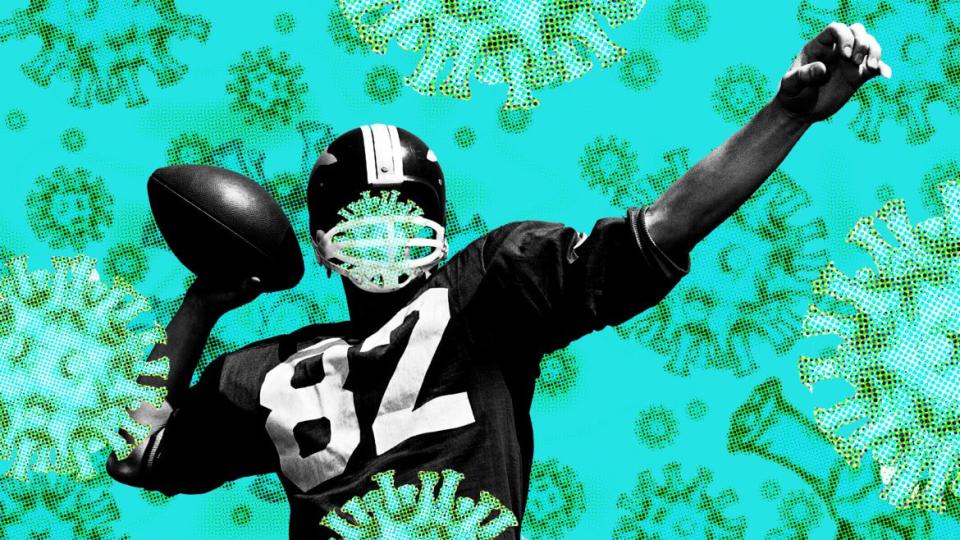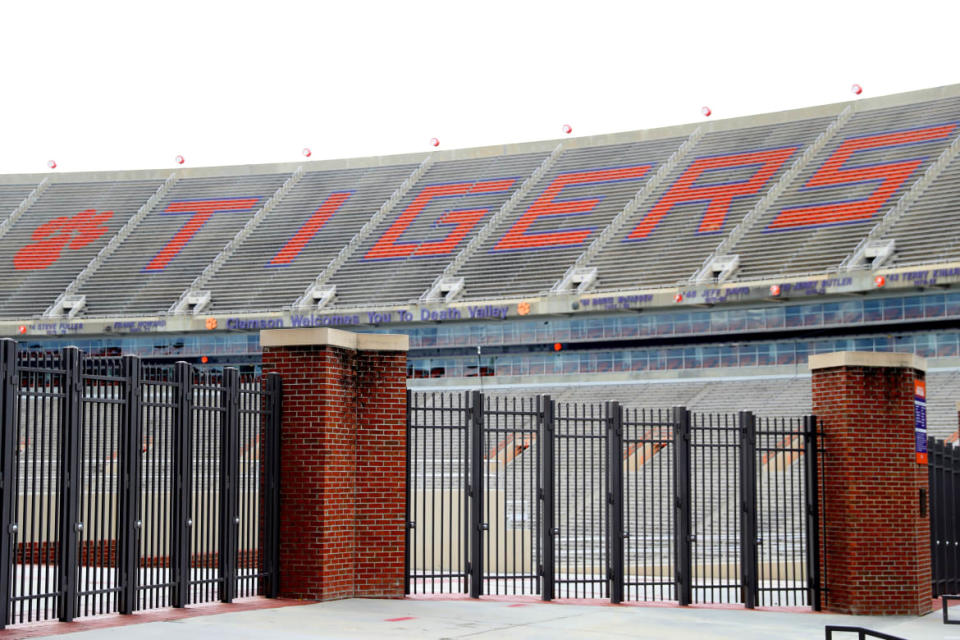Why COVID -19 Outbreaks in College Sports Are Scary as Hell

Gene Taylor thought he was playing it safe when he allowed preseason football practices at Kansas State University to start on June 15. It was two weeks later than some other teams had started practicing—a significant setback in the hyper-competitive Big 12 conference. Every athlete was quarantined for at least a week after they arrived, then tested for the virus. Those who tested negative underwent daily temperature checks and questioning before they could work out. For the first week, it looked like the team had pulled off the impossible: Not one player tested positive.
But a few players showed up late, either because they were freshmen or transfer students, and weren’t tested until the Friday before. The athletics department told them to isolate themselves until the following Monday, when they would get their results back. But college students are college students, and two of them didn’t listen. One player went to a birthday party over the weekend; another went to play video games in an apartment with eight to 10 other people.
“That's when it started to spread,” Taylor told The Daily Beast in an interview this week.“We had two more, and then we had six, and then we had eight.”
On June 20, after 14 student-athletes tested positive for the coronavirus, the school suspended football practice until at least July 14.
“The worry for everybody is, how do you protect these kids?” Taylor said. “We can’t put them in a bubble, they are going to go back to their apartments and dorm rooms.”
He added: “It’s going to be a bumpy road for college football.”
In many ways, it already has been. In the six weeks since the NCAA allowed colleges to start preseason training, at least nine schools have suspended practices because of virus outbreaks on their teams. More than 50 schools have reported one or more cases in the athletics department, and over a dozen have reported more than 30. The Big 10, Pac-12, Atlantic Coast, and Patriots League conferences have all made significant changes to their season schedules, and 14 schools have cancelled them altogether.
Of course, sports teams aren't the only places on campus where coronavirus can spread. (The University of Washington was recently commended for “staying ahead of the coronavirus” after no new athletes tested positive for a week, despite the fact that at least 117 people living in the school’s frat house had tested positive days earlier.) But experts say the results of preseason training contain clues about what we can expect when hundreds of thousands of students return to the 60 percent of U.S. campuses that are restarting in-person education this fall.
These athletes, some experts say, are essentially canaries in a very contagious coal mine.
"I think [these outbreaks] tell us more about what may happen when we get thousands of students back on campus than just what's happening on athletic teams,” said Zachary O. Binney, an epidemiologist at the Oxford College of Emory University.
“In a group that is interacting a lot with one another, this virus spreads quietly,” he added. “We've seen this happen on college campuses with summer sports workouts, and I think there is reason to believe that we may see something similar in the fall.”
The first team to suspend practice this summer was the University of Houston, which temporarily paused workouts on June 12 after six students on various sports teams tested positive for the virus. (Players at Arkansas State University, Auburn, Texas Tech, Boise State, Florida State, the University of Central Florida, the University of Alabama, and Clemson University others had already tested positive, but the teams elected to continue practicing without them.) Taylor’s team at Kansas State was next, followed by Austin Peay and the University of Nevada, Las Vegas—all before the beginning of July.

Clemson Memorial Stadium in South Carolina.
Then, on June 20, at least a quarter of Louisiana State’s football team was quarantined after being potentially exposed to the virus. According to Sports Illustrated, 30 of the team’s 115 players either tested positive for the virus or were found to have been in contact with someone who had. Some of the players were quarantined after going out to nearby nightclubs, where more than 100 patrons had tested positive.
Still, the NCAA continued with its plan to let schools start mandatory workouts as early as July 6. (At the time the plan was announced, NCAA Football Oversight Committee Chairman Shane Lyons said he thought the association had “landed in a very good spot.”) By July 8—two days after mandatory workouts were allowed to start—three more schools had suspended practice.
One of the schools, the University of North Carolina, reported 37 positive cases in its athletics department in less than a month. In an interview with the News and Observer weeks earlier, head football coach Mack Brown had hinted that the team was having trouble, and seemed to question whether the game could be played safely.
“The young players had a player-led practice the other day and I asked, ‘how did it go?’ he said. “One of them said, ‘Not very good.’ Nobody knew how to social distance and play.”
“We’re all trying to do what’s right, we’re trying to be safe, but we’re trying to get our questions answered,” he added.
It’s not that sports are necessarily more dangerous for the spread of the virus than other on-campus activities. In fact, many athletic departments are taking more precautions than will be in place for the general student population—including weekly testing, daily temperature checks, and regular symptom screening. It’s just that the athletes were the first to confront the inherent safety risks of coming back to campus.
Dean L. Winslow, an infectious disease expert at the Stanford University School of Medicine, noted that the LSU players appear to have contracted the virus at bars in town, not at practice. He emphasized that the most important factor in virus spread is not cleaning or hand washing, but the small particles that linger in the air when people congregate indoors.
"It's nothing specific to sports or sports facilities,” he said. “It's really just the amount of time spent indoors with large numbers of people.”
But sports teams do provide one of the most clear-cut examples of what’s pushing colleges to rapidly reopen: political considerations and financial concerns. Republican governors eager to reopen their states have egged on athletics, allowing stadiums to open up as early as last month and declaring that all professional sports teams are welcome in their states. In Georgia, Gov. Brian Kemp has been pilloried in the press for saying residents should wear masks so they can have a football season.
And while Trump has yet to speak out about college sports, some of his most ardent supporters are demanding the season move forward. In an interview on Fox News, former Notre Dame coach Lou Holtz—an early and vocal Trump supporter—compared playing sports in the pandemic to the storming of Normandy: “[The soldiers] knew there was going to be casualties, they knew there was going to be risk, but it was a way of life,” he said.
At the same time, colleges are bleeding money due to the pandemic. For larger institutions, a canceled or even reduced sports season could be a significant blow to their bottom line. According to the U.S. Department of Education, colleges made $14.8 billion off of athletics in 2018, the last year for which data is available. Texas A&M, one of the top-earning schools, made $192.6 million from its teams in 2013 alone. (Head football coach Jimbo Fisher recently praised Gov. Greg Abbott’s decision to reopen stadiums, telling a local radio station he thought the school’s season would be “pretty close to normal.”)
Perhaps because of this, some student-athletes have started advocating for their own protection. In mid-June, as UCLA athletes started pre-season practice, 30 football players signed onto a document saying they did not trust the school to act in their best interest. Among other things, they requested the presence of a third-party health official, protections for anonymous whistleblowers, and a guarantee that each player could decide whether or not to play without fear of losing their scholarship.
“The decision to return to training amidst a global pandemic has put us, the student-athletes, on the frontlines of a battle that we as a nation have not yet been able to win,” the players wrote, in a letter obtained by the Los Angeles Times. “We feel that as some of the first members of the community to attempt a return to normalcy, we must have assurances that allow us to make informed decisions and be protected regardless of our decision.”
Their concerns may not be too far off base. While many schools have promised not to revoke students’ scholarships if they don’t participate this season, several have also required them to sign a waiver releasing the school from liability if they choose to play. A Southern Methodist University waiver obtained by the Dallas Morning News requires players to sign 11 different times, agreeing to “voluntarily assume all risks related to the COVID-19 virus” and waiving their right to litigation.
Ohio State University has asked players to sign a similar document, called “The Buckeye Pledge,” requiring them to adhere to safety protocols but also to acknowledge that they may be exposed to the coronavirus during play. (Gene Smith, Ohio’s athletic director, told ESPN the pledge was more of an educational document than a legal one.) Just this week, the school announced that it was pausing voluntary workouts due to a virus outbreak among student athletes.
Rather than have players assume this risk, or assume it themselves, some schools have elected to cancel their seasons altogether. Bowdoin College and the University of Massachusetts Boston were among the first to cancel their seasons in June, followed by the College of New Jersey, Pratt Institute, Williams College, and Morehouse. In the largest such announcement to date, the presidents of all eight Ivy League schools said this week that they would be cancelling their seasons, too.
Also this week, the Big Ten and Pac-12 conferences announced that they will allow only in-conference games this fall, reducing the need for long-distance travel and helping to promote more universal testing. The Atlantic Coast Conference is reportedly considering a similar move, while the Patriot League, a conference of smaller Northeast schools, has shortened its season and put restrictions on travel.
In a video for the NCAA released last week, PAC-12 commissioner Larry Scott sounded anxious about what the season would hold.
“I think what we've seen over the last few weeks gives us reason to be concerned that when campuses open up, there could be real spikes and pressures on the health-care system,” he said, noting the rising case counts across the country. “From my perspective, that's really the biggest risk to college sports in the fall."
And yet, like the soldiers at the Battle of Normandy, some teams are still charging ahead. After a 14-day pause, Kansas State athletes have arrived back on campus, in hopes of starting up practice once again.
Asked why it was so important for college athletics to continue, Taylor said the question was better suited for the student athletes.
“When I talk to our athletes, these guys have been dying to get back and working out and preparing,” he said. “These kids just want to play.”
He added, “They love the game of football.”
Got a tip? Send it to The Daily Beast here
Get our top stories in your inbox every day. Sign up now!
Daily Beast Membership: Beast Inside goes deeper on the stories that matter to you. Learn more.

